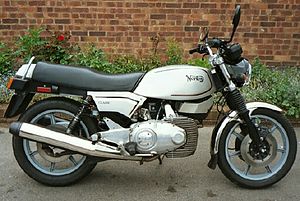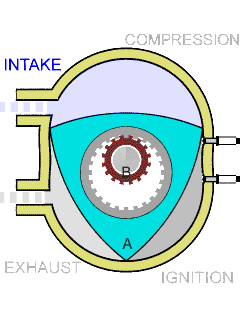
The Wankel engine is a type of internal combustion engine using an eccentric rotary design to convert pressure into rotating motion. The concept was proven by German engineer Felix Wankel, followed by a commercially feasible engine designed by German engineer Hanns-Dieter Paschke. The Wankel engine's rotor, which creates the turning motion, is similar in shape to a Reuleaux triangle, with the sides having less curvature. The rotor spins inside a figure-eight-like epitrochoidal housing around a fixed-toothed gearing. The midpoint of the rotor moves in a circle around the output shaft, rotating the shaft via a cam.

The Norton Motorcycle Company is a brand of motorcycles headquartered in Solihull, West Midlands,, England. For some years around 1990, the rights to use the name on motorcycles were owned by North American financiers.
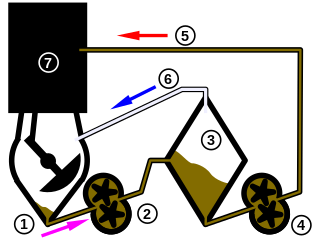
A dry-sump system is a method to manage the lubricating motor oil in four-stroke and large two-stroke piston driven internal combustion engines. The dry-sump system uses two or more oil pumps and a separate oil reservoir, as opposed to a conventional wet-sump system, which uses only the main sump below the engine and a single pump. A dry-sump engine requires a pressure relief valve to regulate negative pressure inside the engine, so internal seals are not inverted.
The GSX Series is Suzuki's range of sport touring motorcycles powered by four-valve per cylinder four-stroke engines. The first GSX models were introduced in 1980 and represented the next step in Suzuki's four-stroke road bike range after the two-valve GS Series.

Matchless is one of the oldest marques of British motorcycles, manufactured in Plumstead, London, between 1899 and 1966. A wide range of models were produced under the Matchless name, ranging from small two-strokes to 750 cc four-stroke twins. Matchless had a long history of racing success; a Matchless ridden by Charlie Collier won the first single-cylinder race in the first Isle of Man TT in 1907.

A motorcycle engine is an engine that powers a motorcycle. Motorcycle engines are typically two-stroke or four-stroke internal combustion engines, but other engine types, such as Wankels and electric motors, have been used.

The Suzuki RE5 is a motorcycle with a liquid-cooled single-rotor Wankel engine, manufactured by Suzuki from 1974 to 1976. Apart from its unusual engine, the RE5 is mostly a conventional roadster, albeit with some peculiar styling details thanks to Italian industrial designer Giorgetto Giugiaro.

Triton motorcycles were hybrid motor cycles built from the 1950s to the 1970s that involved fitting Triumph engines into Norton frames. Because no factory offered Triton motorcycles, they were typically privately built. However, some UK dealers offered complete bikes. The aim was to combine the best elements of each marque and thus gain a bike superior to either. The name 'Triton' is a contraction of Triumph and Norton; 'Triton' was the name of an ancient Greek god.

The X-engine is a type of pistonless rotary engine manufactured by LiquidPiston of Bloomfield, Connecticut.

Hercules was a brand of bicycle and motorcycle manufactured in Germany.
A plenum chamber is a pressurised housing containing a fluid at positive pressure. One of its functions is to equalise pressure for more even distribution, compensating for irregular supply or demand. It is typically relatively large in volume and thus has relatively low velocity compared to the system's other components. In wind tunnels, rockets, and many flow applications, it is a chamber upstream on the fluid flow where the fluid initially resides. It can also work as an acoustic silencer.
The MidWest AE series are lightweight, liquid-cooled, single- and twin-rotor Wankel engines, with dual ignition, designed for light aircraft. They were produced by Mid-West Engines Ltd. at Staverton Airport, Gloucestershire, UK.

A total-loss oiling system is an engine lubrication system whereby oil is introduced into the engine and then either burned or ejected overboard. Now rare in four-stroke engines, total loss oiling is still used in many two-stroke engines.
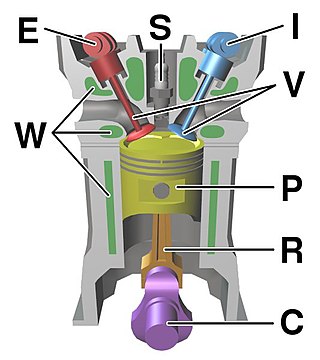
An internal combustion engine is a heat engine in which the combustion of a fuel occurs with an oxidizer in a combustion chamber that is an integral part of the working fluid flow circuit. In an internal combustion engine, the expansion of the high-temperature and high-pressure gases produced by combustion applies direct force to some component of the engine. The force is typically applied to pistons, turbine blades, a rotor, or a nozzle. This force moves the component over a distance. This process transforms chemical energy into kinetic energy which is used to propel, move or power whatever the engine is attached to.

The Hercules W-2000 is a motorcycle which was made by Hercules in Germany. It was the first production motorcycle with a Wankel engine.

The Norton RCW588 is a Works Racing motorcycle, produced for the 1988 to 1994 racing seasons, initially with an air-cooled version of the road-going twin-rotor Wankel engine used in the Classic soon followed by watercooled versions from 1989.
David W. Garside is an inventor and former project engineer at BSA's Kitts Green research facility. He is notable for having developed an air-cooled twin-rotor Wankel motorcycle engine which powered the Norton Classic road bike. Although the Classic was not the first production rotary-engined bike, it was significantly lighter, smoother, more powerful and better-handling than the contemporary Suzuki RE5.

The Suzuki A100 is a Japanese motorcycle from the Suzuki Motor Corporation with production starting in 1966.Similar models were produced by Yamaha and Kawasaki with the YB100 & KH100 models, also with a single-cylinder two-stroke engine and rotary valve being examples.
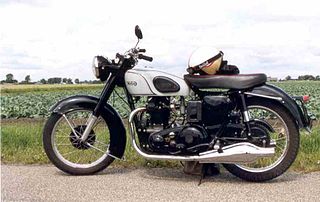
The Norton Model 7 Dominator was a 500 cc vertical twin motorcycle manufactured by the Norton Motorcycle Company from 1949 to 1955. It was the first of Norton's Dominator range of motorcycles. The engine was designed by Bert Hopwood and was a departure from Norton's previous practice of producing single-cylinder machines. The Model 7 was used in Japan as a police motorcycle.

The Suzuki T350, also known as the Suzuki Rebel is a 315 cc (19.2 cu in), two-stroke, twin-cylinder motorcycle produced by the Japanese Suzuki company between 1969 and 1972. The model was based T305 and used an enlarged version of the T305 engine, which itself was an enlargement of the T20 unit. It was the fastest production 350 at the time. In 1972 a T350 was overall winner of the Australian Castrol Six Hour Production race at Amaroo Park but was subsequently disqualified but the same bike won the 500cc class in 1973. The model was dropped when the T380 triple was introduced in 1972.
